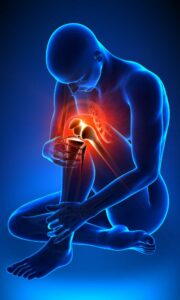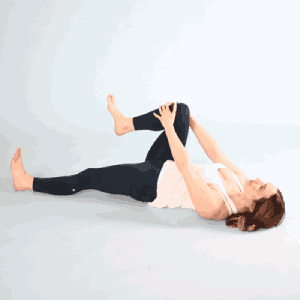Knee pain when bending is a prevalent issue that affects countless individuals, hindering their ability to perform daily activities with ease. Whether it’s walking, climbing stairs, or even sitting down, knee pain can be a significant obstacle. In this article, we’ll delve into the various factors contributing to knee pain when bending, its causes, prevention strategies, treatment options, and exercises to maintain healthy knees.
Contents
Understanding Knee Anatomy

Understanding knee anatomy is crucial for comprehending how the knee joint functions and how various injuries or conditions might affect it. The knee joint is a complex structure that connects the thigh bone (femur) to the shin bone (tibia). It is responsible for supporting body weight, providing stability, and allowing a range of movements like flexion, extension, and limited rotation.
Here’s a breakdown of the key components of knee anatomy:
Bones:
- Femur: The thigh bone forms the upper portion of the knee joint. It has two rounded condyles that articulate with the tibia.
- Tibia: The larger shin bone forms the lower portion of the knee joint. It also has two condyles that articulate with the femur.
- Patella (Kneecap): A small, flat, triangular bone in front of the knee joint. It articulates with the femur and helps protect the joint.
Articular Cartilage:
- The ends of the femur, tibia, and the back of the patella are covered with a smooth, slippery tissue called articular cartilage. This cartilage allows the bones to move smoothly against each other and absorb shock.
Causes of Knee Pain When Bending
Knee pain when bending, also known as flexion, can have various causes, ranging from acute injuries to chronic conditions. Here are some common causes of knee pain when bending:
- Meniscus Tear: A tear in one of the menisci, the C-shaped pieces of cartilage in the knee joint, can cause pain when bending. The pain is often felt as a sharp, localized sensation along the joint line.
- Patellofemoral Pain Syndrome (Runner’s Knee): This condition involves pain around or behind the patella (kneecap) due to improper tracking of the patella along the femoral groove. It can be aggravated by activities that involve bending and straightening the knee, such as squatting or going up and down stairs.
- Osteoarthritis: As the knee joint’s cartilage wears down with age, osteoarthritis can develop, leading to pain and stiffness, especially during movements like bending.
- Rheumatoid Arthritis: An autoimmune disease that affects the joints, rheumatoid arthritis can cause inflammation, pain, and stiffness in the knee joint, including during bending.
- Anterior Cruciate Ligament (ACL) Tear: A tear in the ACL, often caused by sudden twisting or hyperextension of the knee, can result in pain and instability, particularly during activities involving knee flexion.
- Bursitis: Inflammation of the bursae, fluid-filled sacs that cushion the knee joint, can cause pain when bending the knee.
- Iliotibial Band Syndrome: This condition involves inflammation of the iliotibial band, a band of tissue running along the outside of the thigh. It can cause pain on the outer side of the knee during bending and flexion.
- Tendonitis: Inflammation of the tendons that attach muscles to bones, such as patellar tendonitis (jumper’s knee), can lead to pain when bending the knee.
Symptoms and Diagnosis

Symptoms of knee pain can vary widely depending on the underlying cause. When seeking a diagnosis, a healthcare professional will typically perform a comprehensive evaluation, which may include a physical examination, medical history review, and possibly imaging tests. Here are the common symptoms and diagnostic approaches for knee pain:
Symptoms:
- Pain: This can range from dull and achy to sharp and stabbing. The location and type of pain can provide clues about the underlying issue.
- Swelling: Inflammation in the knee joint can lead to swelling, which might be localized or spread throughout the joint.
- Stiffness: Stiffness can make it difficult to fully bend or extend the knee, and it might be more pronounced after periods of inactivity.
- Weakness: Weakness in the muscles around the knee can result from pain or underlying conditions, affecting your ability to bear weight or move comfortably.
- Instability: If ligaments or other stabilizing structures are compromised, you might experience a feeling of the knee “giving way” or lacking stability.
- Clicking or Popping: Unusual sounds during knee movement can sometimes indicate problems with the joint surfaces or structures.
Diagnosis:
- Physical Examination: A healthcare provider will assess your knee’s range of motion, stability, tenderness, and swelling. They may also evaluate your gait and observe any noticeable deformities.
- Medical History: Discussing the onset, duration, and nature of your symptoms can help the doctor narrow down potential causes. They’ll also inquire about any previous injuries or medical conditions.
- Imaging Tests: Depending on the suspected cause, the doctor might recommend imaging tests such as:
- X-rays: These can reveal bone abnormalities, fractures, or signs of osteoarthritis.
- MRI (Magnetic Resonance Imaging): MRI provides detailed images of soft tissues, making it valuable for assessing ligament, tendon, and meniscal injuries.
- CT Scan: A CT scan provides detailed cross-sectional images and might be used to examine bony structures in more detail.
- Ultrasound: Ultrasound can visualize soft tissue injuries, inflammation, and fluid collections.
Prevention and Management
Preventing and managing knee pain involves a combination of lifestyle adjustments, proper body mechanics, and targeted exercises. Here are some strategies for both preventing and managing knee pain:
- Maintain a Healthy Weight: Excess weight puts added stress on the knees, increasing the risk of pain and injury. Maintaining a healthy weight can reduce this stress and prevent knee problems.
- Stay Active: Engage in regular low-impact exercises, such as swimming, cycling, or walking, to strengthen the muscles around the knee joint and improve overall joint health.
- Warm Up and Stretch: Before engaging in physical activity, warm up with gentle movements and perform dynamic stretches to increase blood flow to the muscles and improve joint flexibility.
- Proper Footwear: Choose supportive and well-fitting shoes that provide cushioning and stability. Proper footwear can help distribute forces evenly during activities.
- Avoid Overuse: Listen to your body and avoid overloading the knee joint with repetitive high-impact activities. Incorporate rest days into your exercise routine.
- Maintain Muscle Balance: Focus on exercises that target the quadriceps, hamstrings, and calf muscles to maintain proper muscle balance around the knee joint.
- Proper Technique: When engaging in activities that involve bending or squatting, use proper body mechanics to reduce strain on the knees. Bend at the hips and knees, keeping your back straight.
Treatment Options

The treatment options for knee pain depend on the underlying cause of the pain and the severity of the condition. Here are various treatment options that healthcare professionals may consider:
Conservative Management:
- Rest: Giving the knee time to heal and avoiding activities that worsen the pain.
- Ice and Heat: Applying ice packs to reduce inflammation and heat packs to relax muscles.
- Compression: Using compression wraps or sleeves to reduce swelling.
- Elevation: Elevating the leg when resting to reduce swelling.
Medications:
- Over-the-Counter Pain Relievers: Acetaminophen or nonsteroidal anti-inflammatory drugs (NSAIDs) can help manage pain and inflammation.
- Topical Creams and Gels: These can provide localized pain relief.
A physical therapist can develop a customized exercise program to strengthen muscles, improve joint mobility, and address specific issues causing knee pain.
Injections:
- Corticosteroid Injections: These can provide short-term pain relief by reducing inflammation.
- Hyaluronic Acid Injections: Also known as viscosupplementation, these injections help lubricate the joint and provide cushioning.
Bracing and Support:
Using knee braces or supports can provide stability, reduce strain, and alleviate pain.
Orthotics:
Shoe inserts or custom orthotic devices can help correct foot alignment and reduce knee strain.
Surgical Options:
- Arthroscopy: Minimally invasive surgery using a tiny camera and surgical tools to diagnose and treat certain knee conditions.
- Ligament Reconstruction: Surgical repair or reconstruction of damaged ligaments, such as the ACL.
- Meniscus Repair or Removal: Depending on the extent of the tear, the meniscus can be repaired or partially removed.
- Partial or Total Knee Replacement: In cases of severe osteoarthritis or joint damage, a portion or the entire knee joint might need to be replaced.
Exercises for Knee Health

Engaging in targeted exercises can help improve knee strength, stability, and flexibility, and reduce the risk of knee pain and injury. Here are some exercises that can contribute to overall knee health:
Straight Leg Raises:
- Sit on a chair with your back straight and feet flat on the floor.
- Straighten one leg in front of you and lift it a few inches off the ground.
- Hold for a few seconds, then lower it back down.
- Repeat on both legs.
Hamstring Curls:
- Stand behind a chair or hold onto a stable surface for support.
- Bend one knee, bringing your heel toward your buttocks.
- Hold for a moment, then lower your leg back down.
- Repeat on both legs.
Mini Squats:
- Stand with your feet shoulder-width apart and your arms extended in front of you.
- Slowly bend your knees and hips, as if sitting back into a chair.
- Keep your back straight and your knees aligned with your feet.
- Hold for a second, then return to the starting position.
Clamshells:
- Lie on your side with your legs bent at a 90-degree angle.
- Keep your feet together and lift your top knee while keeping your feet touching.
- Lower the knee back down.
- Repeat on both sides.
Step-Ups:
- Use a sturdy step or platform.
- Step up onto the platform with one leg, then step back down.
- Alternate legs and repeat.
When to Seek Professional Help
Persistent knee pain, worsening symptoms, or limited mobility should prompt a visit to a healthcare professional. Early intervention can prevent further damage and ensure effective treatment.
Conclusion
Maintaining healthy knees is crucial for a high quality of life. By understanding the causes of knee pain when bending, adopting preventive measures, engaging in suitable exercises, and seeking timely medical attention, individuals can overcome this obstacle and continue to enjoy an active lifestyle.
If you’re experiencing Knee pain, physical therapy for knee pain at PhysioMantra can help: Book an online physical therapy session.



